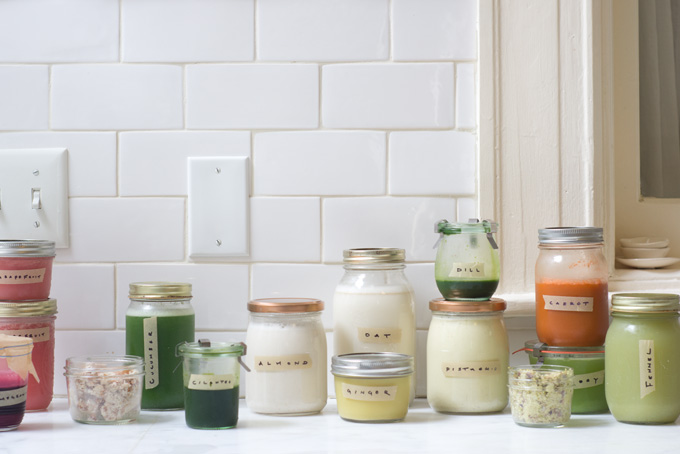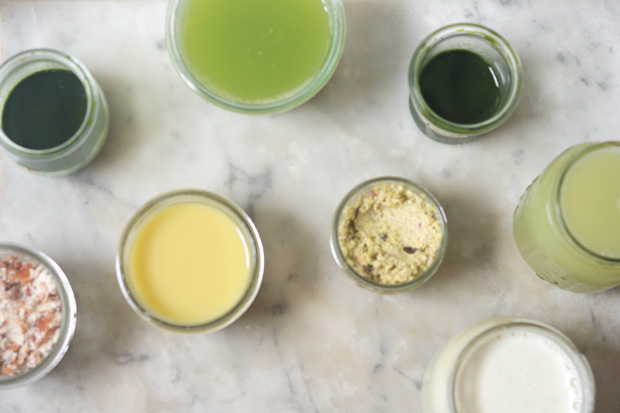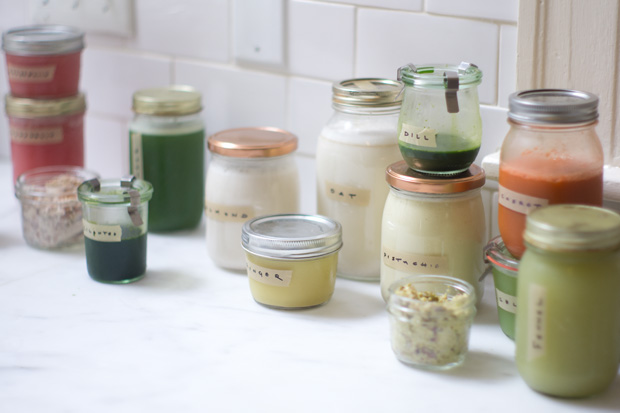أناقتي
عضو متالق


 
 تاريخ الميلاد : 14/10/1979 تاريخ الميلاد : 14/10/1979
 الْمَشِارَكِات : 1343 الْمَشِارَكِات : 1343
 السٌّمعَة : 4 السٌّمعَة : 4
 الإنتساب : 22/12/2011 الإنتساب : 22/12/2011
sms : Healthy Recipes,Cookbooks: Recipes, Cookbooks, and Culinary Adventures
 |  موضوع: A Lesson in Juicing موضوع: A Lesson in Juicing  2/4/2014, 2:32 pm 2/4/2014, 2:32 pm | |
| 
A Lesson in Juicing
January 13, 2013
|
307 Comments
I don't know much about juicers, but I now own one. It's stone heavy, says professional on the label and, generally speaking, seems a bit more hardcore than I would need? My guess is it spent the last ten years on the floor of my parent's pantry. I'll start this post by telling those of you who might be new readers here, I'm a person who didn't have many kitchen appliances until recently - no toaster, no microwave, and I'm happy to juice things by hand. Yet, by happenstance, I've assembled an admirable collection of machines in the past few months. The juicer is just the end of the parade. It landed with a thud at the top of our stairs, boxed in old cardboard, hand-delivered by my dad (apparently banished by my mom after a cleaning binge). And it seems barely used, which I find amusing. Anyway, I let it sit on the counter for about a week, thought about it some, then started juicing everything in sight. I thought I'd share a bit of what I learned...Also, before I dive in, do many of you have juicers? I'd love to hear what you like to make with them.
So, I quite like the juicer(!), and I love the possibilities it lends to expanding my overall ingredient/culinary palette. Fresh juice is invigorating - straight up, blended, or as part of whatever I'm making. It seems the most important thing is to use vibrant, healthy produce. Use the best quality produce you can get, great if it's organic or sustainably grown. If that's not happening, wash it gently, but thoroughly.
A few other observations: The blender and juicer are entirely different beasts. I know this seems obvious, but the blender does chop-chop, and the juicer seems to separate all the fibers and solids from the juices. The juicer produces essences that are incredibly intense, alive, and bright. The flavor is main-lined. I was totally into it. Beyond the fruits and vegetables, I experimented with grains and nuts (see below).
Everyone seems to think using a juicer is a pain in the ass. Primarily the clean-up part. And it was, sort of. But not nearly as bad as I thought. It seems most convenient to juice in batches, set aside what you might use in the immediate future as well as the forthcoming days and then freeze any beyond that immediately. Not as perfect as freshly juiced, but still great.
 
One thing I'll add here, read you juicer's instructions before diving in. What works in mine might not work in your model.
Almond Milk: Soak 1 cup / 5 oz almonds overnight, covered, in filtered water. Drain. Add three cups water, and ladle into juicer. This produces a full-bodied almond milk. If you like it a bit thinner, go with 4 cups water. The flavor really sings when you season it with a touch of salt and sugar. Just go with your taste buds, until it tastes good to you. Makes about 3 1/2 cups. Also, be sure to keep the meaty by-product of making the almond milk, just scrape it out of the juicer. Salt it a bit, and it's a great homemade almond butter.
Oat Milk: Soak 1 cup / 3 oz rolled oats (not instant) overnight, covered, in filtered water. Drain, add 3 cups water, and ladle into juicer. Makes about 4 cups. Note to self to try a version with toasted oats. I could imagine experimenting with it as and ingredient in custards, puddings, french toast, and the like.
Pistachio Milk: Soak 1 cup pistachios / 5 oz overnight, covered, in filtered water. Drain, combine with 3 cups water, and ladle into juicer. This was my favorite non-fruit juice by a stretch. Really nice. I kept trying to combine it with little accents like orange blossom water, or citrus zest, but in the end I liked it best straight. Makes about 3 1/2 - 4 cups. And like the almond milk be sure to keep the meaty by-product of making the pistachio milk, just scrape it out of the juicer. Salt it a bit, and it's a great pistachio butter.
Sesame Milk: Had high hopes for this one but it really didn't work. The unhulled seeds never broke down in the juicer.
 
Fennel Juice: Trim the root end, but use all the rest of it. 1 large bulb = ~1 cup juice.
Celery: Lob off the root end and use the rest. And I didn't bother restringing. 1 medium bunch = 1 1/2 - 2 cups juice. I'm enjoying using the celery juice as a component in all things brothy. The fennel juice as well, but to a lesser extent.
Cucumber: Juice it all. And leave the skin on, it lends a nice color. 1 large (8 oz) cucumber yields about 1 cup of juice. Not really the season for cucumber juice at the moment, but I juiced it anyway. Super cooling.
Cilantro:1 big bunch, leaves and stems = 1/3 cup juice. I threw a couple serranos (deveined and deseeded) into the juicer here as well for a spicy version. You just know it's going to be good swirled into yogurt or creme fraiche and spooned into a bowl of roasted tomato soup!
Dill: 1 large bunch (stems and fronds) yields about 3 tablespoons juice. Equal parts dill juice + olive oil and a pinch of salt has been great over greens, savory pancakes, and eggs this week. I imagine like the other intense herb juices, it would be welcome as a vinaigrette component, drizzled over gratins, and tarts as well.
 
Ginger: 8 ounces unreeled yields about 3/4 cup ginger juice. Freezes quite well. I've been using in teas, broths, citrus juice (grapefruit-ginger is my favorite), dipping sauces, etc.
Grapefruit: 1 large = 1 cup juice. I could live on this during the winter.
Pomegranate: I'm not sure I'd recommend using a juicer here. Mine definitely wasn't happy. That said, the resulting juice is electric - straight-up incredible. Juice the seeds only, but review your juicer's guidelines before an attempt. 1 large pomegranate = ~ 1 cup of seeds = 1/3 cup fresh juice.
Carrots: 1 lb = 1 cup juice. You know, it's just occurring to me as I'm typing this to try a carrot soup with pure juiced carrot. Use it to make the silkiest carrot soup ever.
If you're a juicer, here's my plea to let me know what you use yours most for. Or is it the sort of thing that just collects dust in everyone's pantry for most of the year?
Juice Combinations
A few combinations I tried:
Pistachio Milk: 1/2 cup pistachio milk, 3/4 teaspoon honey or sugar, 1/8 teaspoon sea salt, tiny pinch of ground clove. But like I said up above, this is really good straight.
Spicy Carrot: 1/4 cup carrot juice + 1/4 cup almond milk + 1/16 teaspoon cayenne + 1/2 teaspoon ginger juice + 1/8 teaspoon fine grain sea salt + 2 tablespoons celery juice.
Pomegranate Almond: 1/4 cup pomegranate juice + 1/4 cup almond juice + 2 drop rose water + pinch of salt, 1 teaspoon lemon juice + sweeten to taste.
Cucumber Celery: 1/4 cup cucumber + 1/4 cup celery + 1/16 cayenne + pinch of salt. |
|


